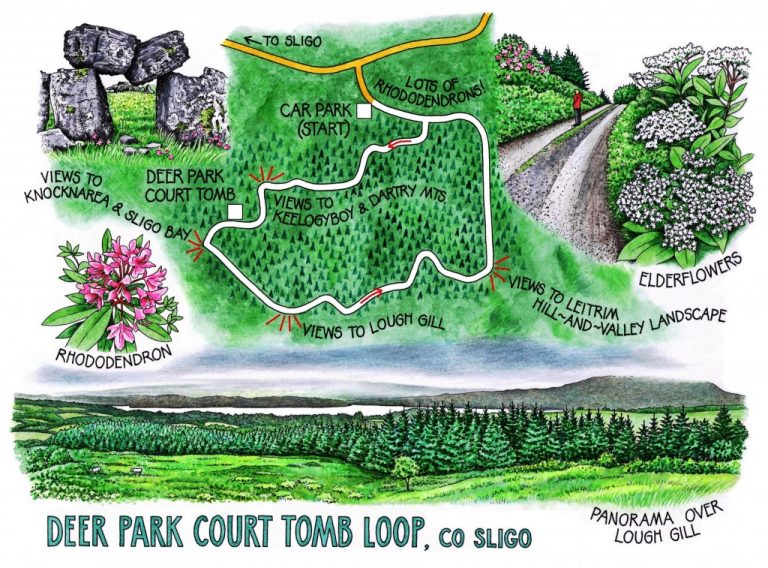Irish Independent Walk of the Week Christopher Somerville
30 July 2011
106: Deer Park Court Tomb Loop, Co. Sligo

It’s funny how something can be either a blessing or a curse, depending on your standpoint. Usually my reaction to the sight of rhododendrons in the landscape is short, sharp and unprintable. What a bloody nuisance they are, wretched introductions spreading their hydra-headed bushes all over everywhere, smothering and shading out weaker native plants like horticultural bullies. But walking up the track into Sligo’s Deer Park I thought they were simply beautiful, blooming in full pinky-mauve glory on all sides and lending a murky day a much–needed dab of bold colour. Off with their heads when they’re out in the wild, I say. But in a well-managed mixed woodland such as the Deer Park, essentially artificial and proud of it – bring on the ‘dendrons.
The rhododendrons weren’t the only Deer Park denizens putting on a show this afternoon. A tiny black long-haired dachshund came dashing down the path, greeting us so vehemently that he barked himself clean off his feet and went sprawling in a heap. Notwithstanding his admirably offensive spirit, he’d have made only a mouthful for the coursing mastiffs who ran down the deer in times past when this enclave in the southern foothills of the Dartry Mountains was a hunting preserve. Nowadays it’s a much valued and utilised resource for the people of Sligo and the many thousands each year who walk the trail through the trees to reach one of Ireland’s supreme archaeological treasures – the Deer Park Court Tomb.
The way to the tomb lay through stands of spruce and pine, as dark and solemn as a cathedral, and by clumps of sallows and tall slender holly trees. Common spotted orchids rose from the carpet of buttercups along the path. Growing low to the ground were some of the sweetest wild strawberries it’s ever been my pleasure to pick. Plump and faintly crunchy with seeds, deep scarlet on one side and white on the other, they looked and felt almost as good as they tasted.
The trail dipped and rose through natural hollows, giving tantalising glimpses out north beyond the tree screen to the cloud-streaming profile of Keelogyboy Mountain. Try as we might, we couldn’t find the stone circle that the map sited close to the path. It must have been completely swallowed by the bracken, heather and tangled brush and sawn stumps of the forest. That didn’t matter in the slightest, once we had topped the rise and reached the court tomb on its elevated knoll.
Whether Leacht Con Mhic an Ruis, the grave of Con, son of Ruis, is Ireland’s finest example of a court tomb is open to question. It’s certainly one of the most resonant sites in the country, a magnificent hundred-foot-long stone-built tomb with a double chamber at the east end, a single one on the west, and a great central court. The deeply seamed limestone slabs do not stand especially tall, but the integrity of the 5,000-year-old structure is remarkable. So is the prospect it commands, north to the crumpled backs of the Dartry Mountains, south over the long flat gleam of Lough Gill. Turning west, the view centres on the dark hump of Knocknarea, with Queen Medbh’s tomb a pimple on the summit; from that the eye slides north to the tidal complexities of shallows, channels and sand bars out in the throat of Sligo Bay. Completing the circle, the eastward prospect encompasses the hills and little valleys of the Leitrim/Sligo border, steep farmland in twenty shades of green.
The court tomb lay in a sea of buttercups and milk-white orchids. A woman sat against one of the uprights, absorbed in the view and the palpable magic of such a place. As we watched from the knoll, Knocknarea changed colour from a lowering purple to gauze grey as a rainstorm came running in towards us from the sea. Jack Yeats, in whose paintings there was ‘always a thought of Sligo’, would have caught the insubstantiality and the blurred edges of the scene.
The homeward path ran between ramparts of cut and stacked logs, the pale orange circles of their sawn butts exuding heavy resinous scents. Horsetails trembled in the wind, each plant shedding a miniature shower of raindrops like a green aspergillum. Wild strawberries glinted among serrated leaves, and flat lacy elderflowers lent a heady champagne scent to the end of the walk.
WAY TO GO
Map: OS of Ireland 1:50,000 Discovery Sheet 25; downloadable map/instructions at discoverireland.ie/walking.
TRAVEL: From Sligo, N16 Enniskillen road; in 1 mile (1.5 km) ahead at traffic lights on R286 (‘Dromahaire’). In ½ mile, left (‘Calry’). In 2½ miles (4 km) pass turning signed ‘Calry School’; in another mile (1.5 km), right (‘Deer Park Court Tomb’) into car park.
WALK DIRECTIONS: Take track past barrier, and follow red arrow waymarks round the Looped Walk.
LENGTH: 2½ miles/ 4 km: allow 1 – 1 ½ hours
GRADE: Moderate
DON’T MISS:
• Supreme views of Lough Gill, Knocknarea, Dartry Mts etc
• Deer Park Court Tomb
• Wild strawberries (best in June!)
REFRESHMENTS: Picnic
ACCOMMODATION: Clarion Hotel, Sligo (071-911-9000; clarionhotelsligo.com) – splendidly over-the-top building; very comfortable; helpful staff.
WALKING in IRELAND: Walking tour operators, local walks including Discover Ireland’s National Loop Walks, walking festivals throughout Ireland: www.discoverireland.ie/walking.
SLIGO TIC: Temple Street, Sligo (071-916-1201); discoverireland.ie/Places-To-Go/Sligo
BOOK: Christopher Somerville’s book Walking in Ireland (Ebury Press) contains 50 of his favourite Irish Independent walks.
csomerville@independent.ie